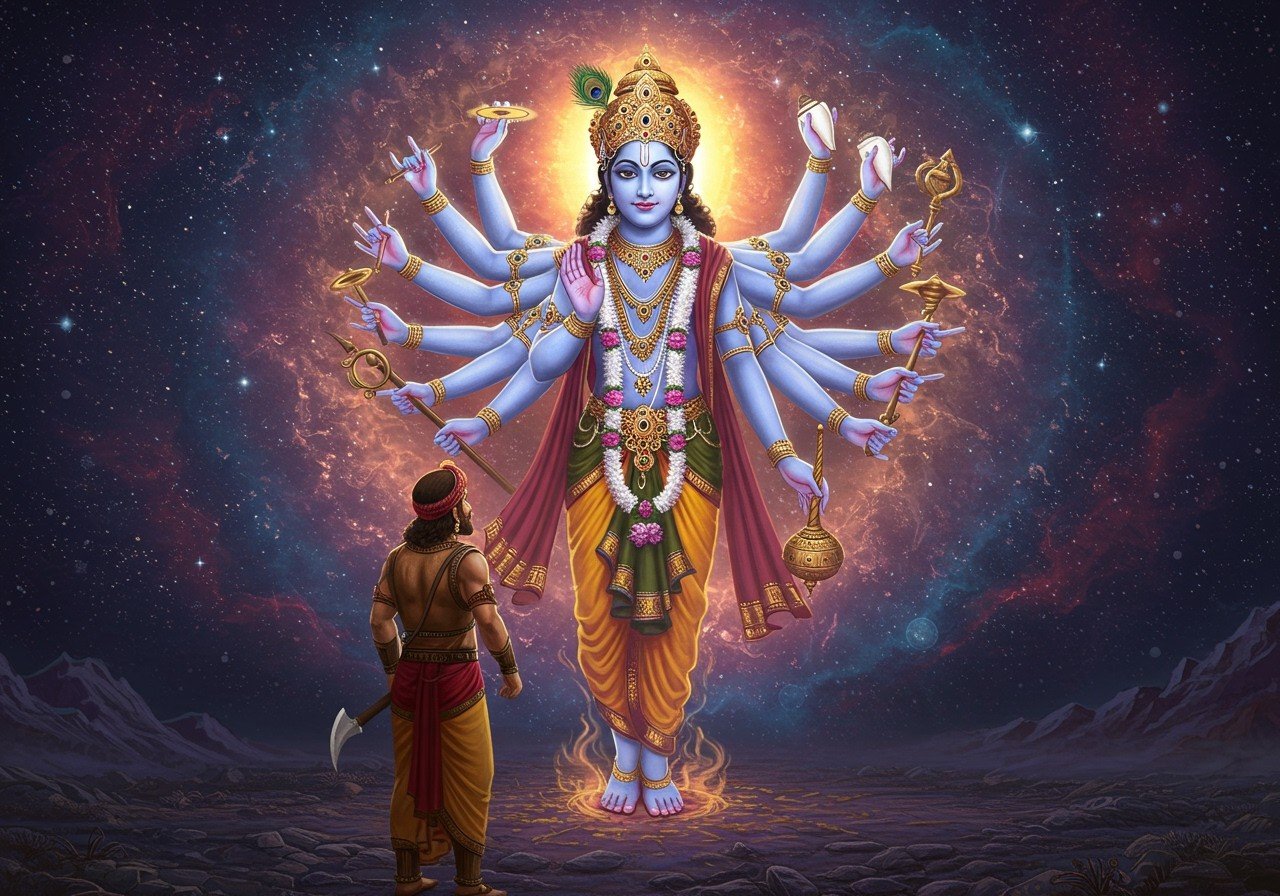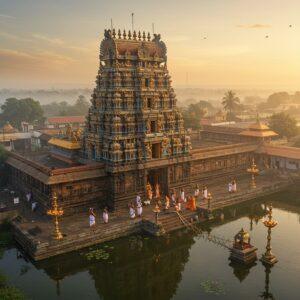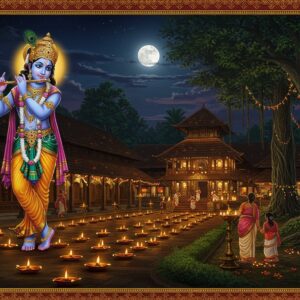
The Bhagavad Gita, a cornerstone of Hindu philosophy, offers profound insights into life, dharma (righteous duty), and the nature of reality. Set against the backdrop of the Kurukshetra war, the dialogue between Prince Arjuna and Lord Krishna unfolds a timeless wisdom. A pivotal moment in this sacred text is the revelation of the Vishvarupa, Krishna’s Universal Form, a spectacle that transforms Arjuna’s understanding and strengthens his resolve.
Exploring the Grandeur of Vishvarupa: A Glimpse into the Divine
Vishvarupa, meaning “Universal Form” or “Omniform,” isn’t merely a vision; it’s a divine unveiling of Krishna’s infinite, all-encompassing nature. Imagine Arjuna, on the battlefield, grappling with the weight of his duty. In this moment of crisis, Krishna grants him a divine sight, the Vishvarupa. This form transcends human comprehension, revealing the interconnectedness of all existence.
Arjuna witnesses a form of immense radiance, like a thousand suns blazing together. Countless faces, arms, and cosmic elements emerge from this form, embodying the entire universe within Krishna. This revelation serves as a powerful reminder that everything is connected, woven together in the fabric of the divine.
Krishna’s Divine Revelation: A Moment of Transformation
Krishna, in his dual role as charioteer and divine guide, unveils the Vishvarupa. Arjuna, overwhelmed by the grandeur of this cosmic form, sees gods, sages, and celestial beings residing within Krishna. The sight is both awe-inspiring and terrifying, shaking Arjuna to his core. Krishna reveals the cyclical nature of life and death, emphasizing the eternal essence of the divine. This experience guides Arjuna to understand his dharma and act with detachment from worldly outcomes.
Decoding the Symbolism of Vishvarupa: A Tapestry of Meaning
The Vishvarupa is rich in symbolism. The countless eyes and mouths represent Krishna’s omnipresence and omniscience, seeing and knowing all. The cosmic fire emanating from the form symbolizes the continuous cycles of creation and destruction. The presence of gods and celestial beings signifies the unity of the divine.
However, the Vishvarupa also portrays wrathful aspects, such as the devouring of warriors, illustrating the inescapable nature of time and destiny. This duality highlights the complex interplay of creation and destruction, order and chaos, within the divine.
The Philosophical Heart of Vishvarupa: Lessons for Life
The Vishvarupa imparts profound teachings. Arjuna learns the importance of surrender, of seeing beyond the limitations of the material world. He grasps the true meaning of dharma, aligning his actions with the divine will.
Krishna’s cosmic form encourages detachment from ego and individuality. It calls for selfless action, recognizing that life is divinely orchestrated. We are but instruments in the hands of the divine, playing our roles in the grand cosmic drama.
Vishvarupa’s Influence on Hindu Culture: An Enduring Legacy
The Vishvarupa has profoundly impacted Hindu art and culture. Temples and ancient manuscripts often depict this cosmic form, capturing its awe-inspiring essence. Artists through the ages have interpreted the Vishvarupa through various mediums, each offering a unique perspective on its complexity.
Festivals and rituals often incorporate readings from the Bhagavad Gita, celebrating its spiritual depth. The narrative of the Vishvarupa continues to inspire devotion and shape Hindu thought, serving as a powerful reminder of the divine’s immanence in the world.
Delve deeper into the origins of the Bhagavad Gita with our exploration of Jyotisar.
How Poojn.in Can Enrich Your Spiritual Journey
At Poojn.in, we understand the profound significance of the Vishvarupa and its role in Hindu tradition. We offer a curated collection of items to deepen your connection with this sacred aspect of Krishna:
-
Vishvarupa Idols: Bring the divine presence into your home with our beautifully crafted Vishvarupa idols, perfect for your personal altar or temple.
-
Bhagavad Gita Texts: Deepen your understanding of Krishna’s teachings with our authentic Bhagavad Gita texts available in various languages.
-
Incense and Puja Items: Enhance your spiritual practices with our exquisite selection of incense sticks, diya lamps, and other puja essentials.
-
Krishna Posters and Art: Adorn your space with vibrant Krishna posters and artwork, featuring Krishna in his various forms, including the majestic Vishvarupa.
-
Sacred Mala Beads: Enhance your meditation and chanting with our collection of genuine mala beads crafted from various materials.
At Poojn.in, we are committed to providing high-quality, authentic ritual items, blending tradition with the convenience of online shopping. For inquiries or to place an order, please call us at 03369029784 or WhatsApp us at 9476142738.
Embracing the Vision: A Path to Deeper Understanding
The Vishvarupa in the Bhagavad Gita serves as a profound reminder of the boundless nature of the divine. Just as Arjuna witnessed this cosmic form, we too are invited to look beyond the surface of things and perceive the interconnectedness of all life. This divine vision inspires us to live with compassion, understanding, and a strong sense of dharma.
Krishna’s Universal Form beckons us to transcend our limited perspectives and embrace a greater truth. It guides us to act with purpose, free from selfish desires, and to find peace in our connection to the divine cosmic order. By honoring this vision, we deepen our spirituality and strengthen our devotion, recognizing the divine spark that resides within each of us.
Frequently Asked Questions about Vishvarupa
What does Vishvarupa represent? The Vishvarupa, Krishna’s cosmic form as revealed in Chapter 11 of the Bhagavad Gita, represents the totality of existence. It showcases Krishna’s infinite nature, encompassing all beings and elements within the universe. This divine form illustrates Krishna’s omnipotence and omniscience, highlighting his role as the ultimate reality.
Why did Krishna reveal the Vishvarupa to Arjuna? Krishna revealed the Vishvarupa to bolster Arjuna’s wavering resolve on the battlefield of Kurukshetra. Arjuna, overwhelmed by the prospect of fighting against his kin, was hesitant to fulfill his duty. The Vishvarupa served as a powerful reminder of Krishna’s divine authority and the importance of dharma, ultimately inspiring Arjuna to action.
How is the Vishvarupa described? The Bhagavad Gita describes the Vishvarupa as a radiant form with countless faces, arms, and eyes. It emanates a brilliance comparable to a thousand suns, encompassing the entire universe within its vastness. This awe-inspiring form instills both fear and reverence, showcasing the duality of creation and destruction inherent in the divine.
What is the significance of the Vishvarupa? The Vishvarupa holds profound significance within Hindu theology. It signifies the interconnectedness of all beings and the omnipresence of the divine. Witnessing this form is considered a transformative experience, leading to a deeper understanding of reality and one’s place within the cosmic order. It reinforces the importance of dharma and encourages surrender to the divine will.
How did Arjuna react to seeing the Vishvarupa? Arjuna’s initial reaction to the Vishvarupa was a mix of awe, fear, and bewilderment. Overwhelmed by the sheer grandeur and power of the cosmic form, he pleaded with Krishna to return to his more familiar, human-like appearance. This underscores the limitations of human perception when confronted with the immensity of the divine.
Is the Vishvarupa visible to everyone? The Vishvarupa is not perceptible through ordinary vision. It is a divine revelation granted only through grace and deep devotion. Krishna granted Arjuna divine sight to perceive this form, emphasizing that such a vision transcends human understanding and requires a special connection with the divine.
What key lesson does the Vishvarupa teach? The Vishvarupa teaches the fundamental lesson of interconnectedness and the omnipresence of the divine. It emphasizes the importance of fulfilling one’s dharma without attachment to personal outcomes, recognizing that everything unfolds according to the divine plan. It encourages surrender, devotion, and a holistic understanding of life’s purpose.


